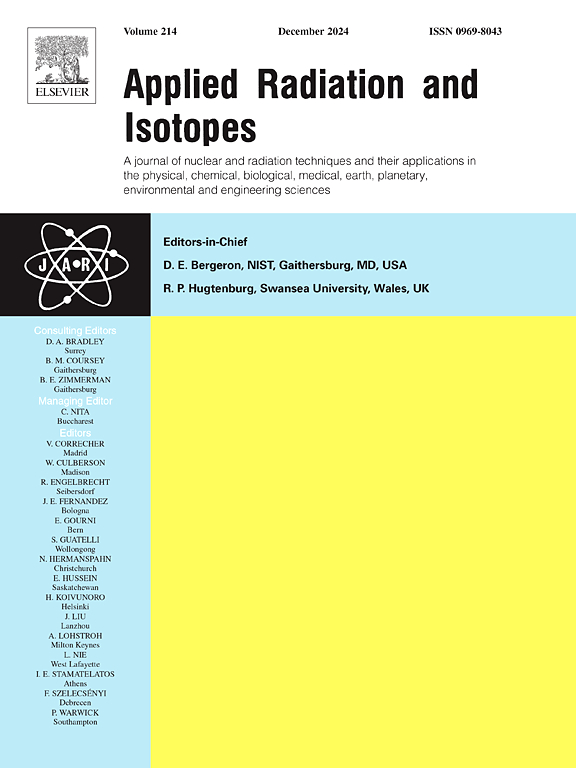Assessing the impact of uncertainty in a VMAT plan for H&N cancer considering patient setup error (PSE)
IF 1.6
3区 工程技术
Q3 CHEMISTRY, INORGANIC & NUCLEAR
引用次数: 0
Abstract
In radiotherapy, accurate radiation dose delivery is critical, despite the uncertainties that can cause discrepancies between the prescribed and administered doses. This study examines the influence of uncertainties caused by patient positioning errors on dose accuracy and evaluates the potential consequences if these errors remain uncorrected. The investigation involves 670 treatment plans, including 10 clinically implemented plans and 660 with artificially induced uncertainties. These plans target patients undergoing volumetric arc therapy (VMAT) for various head & neck cancers using the Halcyon™ medical linear accelerator. Two scenarios are analyzed: one reflecting actual patient positioning shifts and another involving deliberate displacements ranging from 1 to 10 mm to assess the impact of uncertainty in a VMAT plan. Dosimetric validation is performed using EPID and the Octavius 4D phantom to introduce and assess the impact of these uncertainties. Results indicate that target coverage falls below the acceptable V95% threshold along the (X+, X-), (Y+, Y-), and (Z+, Z-) axes, when positioning errors exceed 5 mm. Additionally, both parotid glands are significantly affected by positioning uncertainties. Patient-specific quality assurance (PSQA) assessments confirm that positioning errors substantially affect the accuracy of dose delivery. To minimize uncertainties, strict adherence to recommended QA, clinical guidelines, imaging protocols, and other SOPs is crucial in clinical practice. Independent dosimetric audits are essential for evaluating the accuracy of dose delivery in treatment.
考虑患者设置误差(PSE)的H&N癌症VMAT计划的不确定性影响评估
在放射治疗中,准确的放射剂量递送至关重要,尽管不确定性可能导致处方剂量和给药剂量之间的差异。本研究探讨了由患者定位错误引起的不确定性对剂量准确性的影响,并评估了如果这些错误得不到纠正的潜在后果。调查涉及670个治疗方案,其中临床实施方案10个,人为不确定方案660个。这些计划的目标是接受各种头部体积弧治疗(VMAT)的患者。使用Halcyon™医用直线加速器治疗颈癌。分析了两种情况:一种反映了实际的患者体位变化,另一种涉及故意位移,范围从1到10毫米,以评估VMAT计划不确定性的影响。使用EPID和Octavius 4D幻影进行剂量学验证,以引入和评估这些不确定性的影响。结果表明,当定位误差超过5 mm时,目标在(X+, X-)、(Y+, Y-)和(Z+, Z-)轴上的覆盖率均低于可接受的V95%阈值。此外,两个腮腺都受到定位不确定性的显著影响。患者特异性质量保证(PSQA)评估证实,定位错误严重影响给药的准确性。为了最大限度地减少不确定性,严格遵守推荐的QA、临床指南、成像方案和其他sop在临床实践中至关重要。独立的剂量学审核对于评估治疗中剂量传递的准确性至关重要。
本文章由计算机程序翻译,如有差异,请以英文原文为准。
求助全文
约1分钟内获得全文
求助全文
来源期刊

Applied Radiation and Isotopes
工程技术-核科学技术
CiteScore
3.00
自引率
12.50%
发文量
406
审稿时长
13.5 months
期刊介绍:
Applied Radiation and Isotopes provides a high quality medium for the publication of substantial, original and scientific and technological papers on the development and peaceful application of nuclear, radiation and radionuclide techniques in chemistry, physics, biochemistry, biology, medicine, security, engineering and in the earth, planetary and environmental sciences, all including dosimetry. Nuclear techniques are defined in the broadest sense and both experimental and theoretical papers are welcome. They include the development and use of α- and β-particles, X-rays and γ-rays, neutrons and other nuclear particles and radiations from all sources, including radionuclides, synchrotron sources, cyclotrons and reactors and from the natural environment.
The journal aims to publish papers with significance to an international audience, containing substantial novelty and scientific impact. The Editors reserve the rights to reject, with or without external review, papers that do not meet these criteria.
Papers dealing with radiation processing, i.e., where radiation is used to bring about a biological, chemical or physical change in a material, should be directed to our sister journal Radiation Physics and Chemistry.
 求助内容:
求助内容: 应助结果提醒方式:
应助结果提醒方式:


